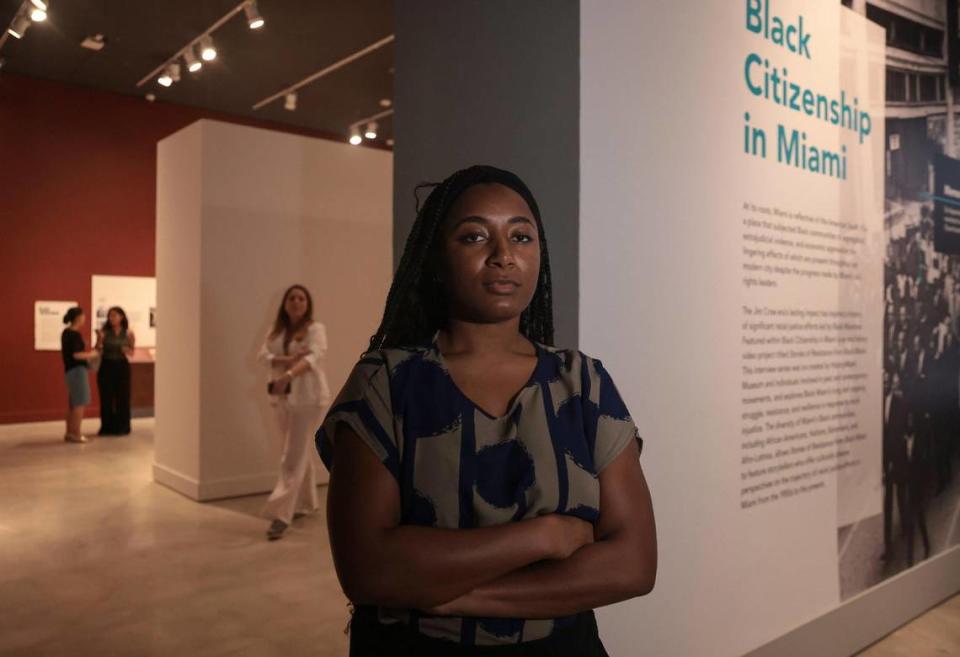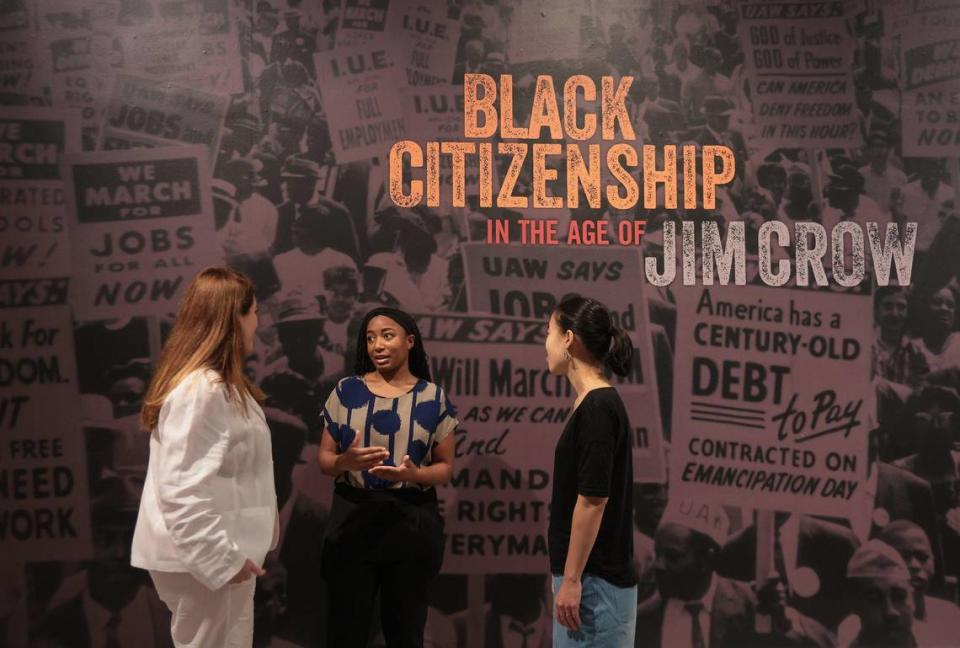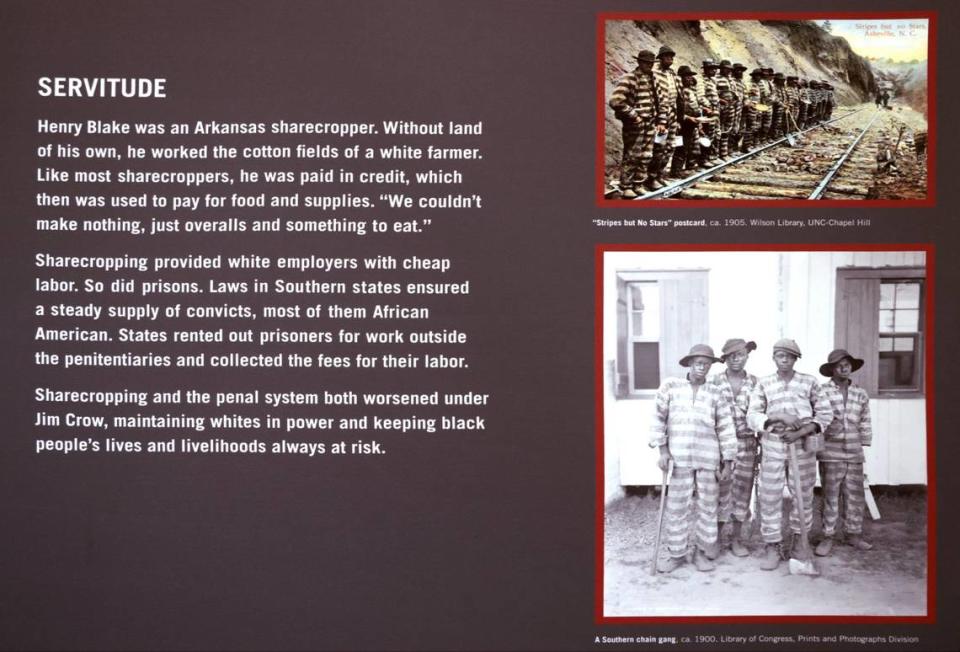‘This is hard history.’ New exhibit details Black people’s fight for American citizenship
Lonnie Lawrence feels a bit surreal as he watches a video of himself at HistoryMiami Museum.
On the screen he tells the following story: Miami police picked up the then-teenager on suspicion he had sexually assaulted a white woman the previous evening. Lawrence had been in his room since last night yet Miami police took him from his house, brought him to the station and held him for a few hours.
Nearly half a century later, Lawrence links that moment to him pursuing a career in law enforcement. “I said ‘There’s something fundamentally wrong with what happened to me,’ ” he recalled, “ ‘and I want to be on the side of trying to make sure that as much as possible I can keep it from happening to other people.’ ”
He recognizes his experience turned out much better than those of many other Black people during the Jim Crow era. “I wouldn’t be sitting here doing this interview,” said Lawrence, who retired as a Miami-Dade police district commander in 1989 after 20 years.
Lawrence’s tale is one of many featured in the “Stories of Resistance from Black Miami” project, a collection of oral histories that supplement HistoryMiami’s new “Black Citizenship in the Age of Jim Crow” exhibit that opens Friday and runs through Feb. 12, 2023. Organized by the New-York Historical Society, the traveling exhibit chronicles Black America’s fight for racial equality from the end of the Civil War until the Civil Rights Movement through key figures and historical artifacts, both replicated and authentic, with the accompanying “Black Miami” project providing a more local angle.

“A lot of what we look at today was built by our hands,” said Anita Francois, the HistoryMiami assistant curator of Haitian and East African descent who put together the “Black Miami” project. “I think it’s important to talk about the stories that led us to where we are, to what exists today and the experiences that are still had because Jim Crow may have passed but the effects of it still linger.”
“Black Citizenship” uses ideals enshrined in the Constitution — democracy, equality, life, liberty and the pursuit of happiness — to frame the fight against racial prejudice. Sections bear these principles to showcase how rights were given and subsequently snatched away from Black Americans. This context chips away at the misconception of American exceptionalism, acknowledging the dark periods of U.S. history yet always highlighting Black achievement along the way.
Most of the exhibit details the triumphs — Black Americans registering to vote, serving in Congress and finding formerly enslaved family members. But it also focuses on the tragedies — formation of the Ku Klux Klan, the Freedmen’s Bureau failure and violent voter suppression — of the Reconstruction Era that laid the groundwork for Jim Crow.

Unheralded historical figures like Maggie Walker, the first woman to start a bank in America, and Henry O. Flipper, the U.S. Army’s first Black commissioned officer, add new faces to the idea of Black resistance while artifacts like a postcard depicting a lynching, slave shackles and a miniature replica of Monument Avenue, a collection of statues honoring the Confederacy that stood in Richmond, Virginia, until 2020’s racial reckoning, show the subtle ways prejudice has ingrained itself into American culture.
Jim Crow was “a steady basically scaffolding of laws and injustices that pile on and pile on and become normalized, both in everyday life and then federal law,” said Lily Wong, the New-York Historical Society curator behind “Black Citizenship.”

Similarly, the “Black Miami” project defies the “facade” of majority minority cities being beacons of racial harmony, Francois said.
“It shows the effects of Jim Crow in a city that’s really disassociated with the American South,” Francois added.
Through interviews with Lawrence and other pillars such as Dorothy Jenkins Fields, Thelma Gibson and T. Willard Fair, visitors can gain a better understanding of how segregation impacted Black Miami. Placards labeled extrajudicial violence and economic oppression provide additional details about what it was like living in Jim Crow Miami. Taken in combination, both “Black Citizenship” and “Black Miami” force onlookers to undergo serious introspection, said Wong.
“I hope that it makes them think about who we are as a nation, who we have been and what we can try to be; this is hard history,” Wong concluded. “This is not easy to go through but I think there’s inspiration to be found, there’s courage even amidst darkness.”
BLACK CITIZENSHIP IN THE AGE OF JIM CROW
When: Oct. 14-Feb. 12, 2023; 10 a.m.–4 p.m. Wednesday–Saturday; noon–4 p.m. Sunday.
Where: HistoryMiami Museum, 101 W Flagler St., Miami

